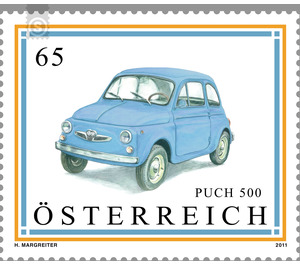automobile - Austria / II. Republic of Austria 2011 - 65 Euro Cent
Theme: Science
| Country | Austria / II. Republic of Austria |
| Issue Date | 2011 |
| Face Value | 65.00 |
| Edition Issued | 250,000 |
| Printing Type | offset |
| Stamp Type | Commemorative |
| Item Type | Stamp |
| Chronological Issue Number | 2251 |
| Chronological Chapter | OOS-OE2 |
| SID | 395556 |
| In 63 Wishlists | |
History: The "Puch-Werke", founded in 1899 by a certain Johann Puch, were an Austrian company that also produced cars in addition to bicycles, engines and motorcycles. Johann Puchs's first small manufacturing facility was located in the Strauchergasse in Graz, and a few years later the production moved to a larger, for that time modern factory. This parent plant, later also called "Einser-Werk", was built in the south of Graz in the district of Puntigam. In 1912, Johann Puch left his company and became its honorary president. At that time, the company employed more than 1,000 workers, producing about 16,000 bicycles each year and 300 motorcycles and cars each. In 1928, Austro-Daimler-Puchwerke A.G. was formed from the merger of Austro-Daimler, the Oeffag and the Puch plants. After a co-operation of both companies already existed starting from 1930, merged 1934 Austro Daimler Puch with the Steyr AG to the Steyr Daimler Puch AG. Like almost all companies of this kind, the Puch factory was used for armaments production during the Second World War, but the existing capacities were soon no longer sufficient. For this reason, the so-called "Zweier-Werk" was built in Thondorf near Graz. After the war, bicycles, mopeds, motorcycles, passenger and off-road vehicles were produced here. One of these models was the "Puch 500", whose development was not without difficulties. The enormous costs of a complete redesign or the production of an own body threatened to let the project fail right at the beginning. Only through a contract with the Turin car company Fiat could save the production of its own body - it was enough to buy the body of the Fiat 500 and adapt. Only the engine cover and in later years the solid roof were produced in-house. Nevertheless, the differences between the Italian Fiat and the Austrian Steyr-Puch were large: In contrast to the air-cooled twin engine of the Fiat, the Puch contained a 2-cylinder boxer engine with 493 cc - and the gearbox chassis unit was completely in Graz manufactured and partly completely different construction approaches. Finally, in 1957, the first Puch 500 rolled out of the factory as a "convertible variant"; the 16-hp model with folding roof was designed primarily to appeal to motorcyclists as target audiences. The sale of the small car was extremely successful; Of the nearly 60,000 vehicles produced between 1957 and 1975, many were sold outside Austria, despite the license clauses of Fiat, most of them in Germany.


